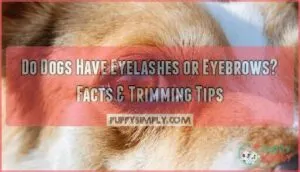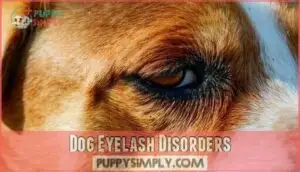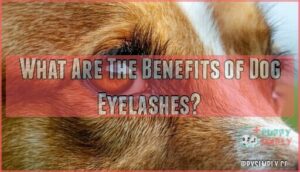This site is supported by our readers. We may earn a commission, at no cost to you, if you purchase through links.

Your pup’s eyelashes grow only on the upper eyelid and serve as tiny guardians, protecting their eyes from dust and debris.
Think of them as nature’s built-in windshield wipers.
As for eyebrows, dogs don’t actually have them in the human sense.
What you’re seeing are facial muscles covered in fur or distinctive markings that create the illusion of expressive brows.
These "eyebrow" areas help your dog communicate emotions through facial expressions.
However, certain breeds sport more pronounced markings that’ll make you think twice about trimming decisions.
Table Of Contents
- Key Takeaways
- Do Dogs Have Eyelashes?
- Can I Cut My Dog’s Eyelashes?
- Do Dogs Have Eyebrows?
- Does Trimming Dog Eyelashes Affect Vision?
- Dog Eyelash Disorders
- What Are The Benefits of Dog Eyelashes?
- Frequently Asked Questions (FAQs)
- Do dogs have eyelashes?
- Why do dogs have long lashes?
- Do dogs have eyebrows?
- Are long eyelashes good for dogs?
- Which dog breeds have longer eyelashes?
- Are short eyelashes bad for dogs?
- Do dogs have eyebrows and eyelashes?
- Are you supposed to cut a dog’s eyelashes?
- Do dogs get eyelashes in their eyes?
- Do dogs have top and bottom eyelashes?
- Conclusion
Key Takeaways
- Your dog has eyelashes only on their upper eyelids that serve as natural protectors, filtering out dust, debris, and harmful UV rays while triggering protective blinking reflexes when objects get too close.
- You shouldn’t trim your dog’s eyelashes unless they’re obstructing vision or causing irritation, as these protective hairs take 5-6 weeks to regrow and are essential for maintaining healthy eyesight.
- Your dog doesn’t have true eyebrows like humans do, but they’ve got specialized facial muscles and distinctive fur markings that create expressive "eyebrow" looks, especially in breeds like Rottweilers and German Shepherds.
- You can safely trim eyebrow markings for grooming purposes, but watch for eyelash disorders like trichiasis and distichiasis that cause misdirected lashes to irritate your dog’s eyes and require veterinary attention.
Do Dogs Have Eyelashes?
Yes, your dog has eyelashes! These protective hairs grow exclusively on the upper eyelid in two to four rows.
Dog eyelashes serve as nature’s safety goggles, shielding canine vision from dust, debris, and bright sunlight.
The eyelash anatomy includes tactile sensors that trigger blinking when objects approach too closely.
Eyelash function extends beyond mere eye protection—they’re essential for maintaining healthy vision.
Dog eyelash growth varies by breed, with longer-haired dogs typically sporting more prominent lashes.
These canine eyelashes work tirelessly to keep your pup’s eyes comfortable and safe.
Regular checks for eye infection signs can help prevent serious issues and guarantee your dog’s eyelashes continue to function properly.
Can I Cut My Dog’s Eyelashes?
While dog eyelashes serve important protective functions, you can trim them when necessary.
Here’s what you need to know about eyelash trimming:
- Safety first: Use sharp scissors and steady hands to avoid eye injury during dog grooming
- Growth timeline: Dog eyelash growth takes 5-6 weeks to return to original length
- When to trim: Only cut when eyelashes obstruct vision or cause irritation
- Professional help: Consider visiting a groomer for precise eyelash care
- Protective function: Remember that eyelashes shield eyes from debris and sunlight
Always prioritize pet safety over cosmetic preferences when considering dog eyelash trimming procedures.
To guarantee safe trimming, understand the importance of proper grooming techniques to avoid accidents.
Do Dogs Have Eyebrows?
While you won’t find actual eyebrows like yours on your dog’s face, they do have specialized muscles above their eyes that create those irresistible expressive looks.
These facial muscles work together to produce the classic "puppy dog eyes" that help your furry friend communicate emotions and strengthen the bond between you two, which can be described as an irresistible way to connect.
Which Dog Breeds Have Eyebrows?
Several breeds showcase prominent eyebrow markings that make their facial expressions particularly enchanting. Rottweilers lead the pack with their distinctive tan-colored spots above each eye, creating that classic "tough guy with a soft heart" look.
Doberman Pinschers sport similar markings, though theirs tend to be more subtle. German Shepherds often display faint eyebrow lines that enhance their alert expressions, while Bernese Mountain Dogs feature rust-colored patches that frame their gentle eyes beautifully.
The Beauceron’s eyebrow genetics produce striking tan markings, and Australian Kelpies show varied breed markings depending on their coat color. Gordon Setters exhibit rich mahogany eyebrow accents, while Boxers display lighter-colored facial hair above their eyes.
Miniature Schnauzers and Airedale Terriers round out this distinguished group with their own unique canine expressions. These dog breeds with eyebrows didn’t develop these features by accident—their eyebrow genetics serve important communication functions, helping both humans and other dogs read their facial expressions more clearly.
Proper pet grooming tools are essential for maintaining their distinctive looks.
Why Do Dogs Have Eyebrow Markings?
Unlike humans, dogs don’t have true eyebrows, but they’ve developed something even more impressive. Your dog’s "eyebrow markings" aren’t just for show – they’re communication powerhouses that reveal fascinating evolutionary adaptations.
Dogs have developed specialized eye muscles in their brow area that gray wolves lack entirely. These muscles allow your pup to create those irresistible "puppy dog eyes" by widening and narrowing their gaze to show emotion. It’s like having built-in mood rings above their eyes!
The markings around your dog’s brow bones serve as visual amplifiers for canine communication. When your dog raises those "eyebrows," they’re highlighting the facial expressions that help them connect with you and other animals. This facial structure enhancement makes their eye movements more noticeable and expressive.
These eyebrow markings basically act as makeup for dogs – they emphasize the canine facial features used in social interactions, making emotional signals clearer and more effective during communication. Regular grooming with proper pet grooming tools can help maintain their appearance and overall health.
Is It Okay to Trim Dog Eyebrows?
Before you reach for those grooming scissors, consider whether your dog’s eyebrows actually need trimming. Most dogs don’t require eyebrow trimming unless the hair interferes with their eyes, mouth, or ears. However, certain breeds like Cocker Spaniels benefit from careful eyebrow function maintenance when fur obstructs vision.
Pet safety should guide your dog grooming decisions. Avoid trimming eyebrows from the nose upward, as this increases eye injury risks. Remember, dog eyebrows help your pup sense their surroundings—cutting them may reduce spatial awareness.
Some professional groomers include eyebrow trimming in routine canine cosmetics services, particularly for spaniel breeds. Yet there’s no expert consensus on this practice.
If you’re considering dog eyebrow trimming, consult your veterinarian first. They’ll assess whether eyelid care modifications are medically necessary. When in doubt, leave those expressive brows alone—your dog’s natural appearance often works best for both function and charm. For show dogs, understanding grooming techniques is essential to maintain their breed standards.
Does Trimming Dog Eyelashes Affect Vision?
Trimming your dog’s eyelashes can impact their vision, but not how you’d expect.
Long lashes might create vision obstruction by blocking sight lines, especially in breeds like Cocker Spaniels.
However, eyelash trimming removes natural eye protection against debris and sunlight.
Your pup’s canine vision actually benefits from intact lashes that filter harmful elements.
If you must trim for comfort, expect lash regrowth within five to six weeks.
Consider your dog’s eye health carefully—those seemingly bothersome lashes serve as tiny bodyguards for their precious peepers.
Proper dog grooming techniques are essential to maintain your dog’s overall eye health and safety.
Dog Eyelash Disorders
While your dog’s eyelashes typically protect their eyes from debris and irritation, sometimes these protective hairs can grow in the wrong direction or location, causing discomfort instead of relief.
You’ll want to recognize the signs of common eyelash disorders like trichiasis and distichiasis, which can lead to corneal irritation, excessive tearing, and painful eye conditions that require veterinary attention.
Trichiasis
When your dog’s eyelashes start growing in the wrong direction, trichiasis becomes a painful reality that can turn those adorable peepers into sources of constant irritation. This eyelash misdirection occurs when normally positioned hairs curve inward toward the cornea, creating ongoing friction that’s like having sand in your eye all day long.
Canine trichiasis particularly affects flat-faced breeds like Pugs and Bulldogs, whose prominent eyes make them sitting ducks for this condition. The misdirected dog eyelashes constantly scratch the corneal surface, leading to serious complications if left untreated.
Watch for these telltale signs of trichiasis:
- Excessive tearing and watery discharge
- Persistent squinting or pawing at eyes
- Red, inflamed eyelids and conjunctiva
- Cloudy or discolored corneal areas
Eye injuries from trichiasis can escalate into corneal ulcers, requiring immediate veterinary intervention. Unlike other eyelash disorders, trichiasis involves normal hair follicles producing problematic growth patterns. Early detection prevents permanent eye damage and keeps your pup comfortable. Regular use of dog eyelash trimmers can help alleviate the discomfort caused by trichiasis.
Distichiasis
Often mistaken for simple irritation, distichiasis represents one of the most common lash disorders affecting our canine companions.
This condition occurs when abnormal lashes grow from meibomian gland openings along the eyelid margin, creating unwanted contact with your dog’s cornea.
You’ll notice eye irritation, pawing, and discomfort in affected dogs. Breeds like Cocker Spaniels and Bulldogs face higher risks due to genetic predisposition.
Treatment ranges from monitoring mild cases to lash surgery for severe irritation. Eyelash removal through surgical extraction effectively addresses problematic hairs, while topical lubricants provide comfort.
Early intervention prevents long-term vision complications in canine eye health management.
| Symptom | Description | Severity |
|---|---|---|
| Excessive tearing | Clear discharge from affected eye | Mild to moderate |
| Squinting/blinking | Difficulty keeping eye open | Moderate |
| Corneal scarring | White or dark spots on eye surface | Severe |
Dog Breeds With Eyebrow Markings
Beyond their functional eyelashes, certain dog breeds sport distinctive facial markings that create the illusion of eyebrows. These breed characteristics aren’t true eyebrows but rather pigmented patches that enhance canine expressions and facial features.
Rottweilers showcase prominent tan spots above their eyes, while Golden Retrievers display lighter eyebrow styles that frame their gentle gaze. Doberman Pinschers, German Shepherds, and Bernese Mountain Dogs also feature these striking facial markings.
These eyebrow markings likely evolved to improve communication between dogs and humans. The contrasting colors make canine eyebrows more visible, allowing us to read their facial expressions better.
Dog breeds with eyebrows don’t require special dog eyebrow care – these markings are simply coat color patterns. However, keeping the surrounding fur trimmed can help highlight these natural facial features and maintain your pup’s expressive appearance.
What Are The Benefits of Dog Eyelashes?
In the context of protecting your dog’s precious peepers, those little lashes above their eyes work overtime as nature’s own security system.
Dog eyelashes serve as your pet’s first line of defense against environmental hazards that could compromise their vision health.
These specialized hairs act as a debris guard, filtering out dust particles, pollen, and other irritants before they reach the sensitive cornea.
Beyond basic eye protection, canine eyes benefit from the sun shield effect that longer lashes provide, reducing glare and preventing UV damage.
The tactile sense function of dog eyelashes shouldn’t be underestimated either – they’re basically early warning sensors that trigger protective blinking reflexes when objects approach too closely.
- Debris Guard: Filters dust, dirt, and airborne particles
- Sun Shield: Reduces harmful UV exposure and glare
- Tactile Sense: Triggers protective blinking reflexes automatically
- Vision Health: Maintains clear sight by preventing irritation
- Pet Eye Care: Supports overall ocular hygiene and comfort
Frequently Asked Questions (FAQs)
Do dogs have eyelashes?
Yes, your dog’s got two to four rows of eyelashes on their upper eyelids—but none below.
These tactile guardians protect against debris, sunlight, and irritation while helping create those irresistible "puppy dog eyes" you can’t resist.
Why do dogs have long lashes?
Dogs develop long lashes as nature’s protective shield for their eyes.
You’ll notice longer lashes on breeds with flowing coats because they need extra defense against debris, dust, and sunlight that could damage their vision, with longer lashes serving as a natural barrier.
Do dogs have eyebrows?
Unlike humans’ prominent brow ridges, your dog doesn’t possess traditional eyebrows.
Instead, they’ve got specialized facial muscles above their eyes that create those irresistible "puppy dog eye" expressions you can’t resist during treat time.
Are long eyelashes good for dogs?
Long eyelashes aren’t just adorable—they’re functional armor for your dog’s eyes.
They filter debris, block harsh sunlight, and trigger protective reflexes.
However, excessively long lashes can obstruct vision and require careful trimming by professionals.
Which dog breeds have longer eyelashes?
Picture those gorgeous, fluttering lashes framing soulful eyes!
You’ll find the longest eyelashes on long-haired breeds like Cocker Spaniels, Maltese, Shih Tzus, Yorkshire Terriers, and Poodles—nature’s way of protecting their precious peepers from debris.
Are short eyelashes bad for dogs?
Short eyelashes aren’t bad for your dog—they’re perfectly normal and still provide essential eye protection.
You shouldn’t trim naturally short lashes since they’re designed to shield eyes from debris and irritation effectively.
Do dogs have eyebrows and eyelashes?
Yes, dogs have eyelashes on their upper eyelids—typically two to four rows that protect their eyes from debris.
They don’t have traditional eyebrows, but facial muscles create expressive looks we recognize.
Are you supposed to cut a dog’s eyelashes?
You shouldn’t trim your dog’s eyelashes unless they’re obstructing vision or causing eye irritation.
These protective hairs shield eyes from debris and sunlight.
If trimming’s necessary, consult your vet or professional groomer for safety.
Do dogs get eyelashes in their eyes?
When Bella’s long Cocker Spaniel lashes started irritating her cornea, her vet diagnosed distichiasis – abnormal eyelash growth.
Yes, you’ll notice dogs can develop ingrown or misdirected eyelashes that cause redness, tearing, and discomfort requiring veterinary attention, which is related to distichiasis.
Do dogs have top and bottom eyelashes?
Dogs have eyelashes only on their upper eyelids, typically arranged in two to four rows.
You won’t find any eyelashes on their lower lids—that’s just how canine anatomy works, unlike humans who’ve both.
Conclusion
Like a vigilant sentinel standing guard at a castle gate, your dog’s eyelashes protect their precious vision from environmental threats.
Understanding whether dogs have eyelashes or eyebrows helps you make informed grooming decisions. Your pup’s upper eyelid lashes serve essential protective functions, while their "eyebrows" are simply muscular expressions enhanced by fur patterns.
Never trim functional eyelashes, but you can safely groom eyebrow markings if needed. Remember, these features aren’t just aesthetic—they’re evolutionary adaptations that keep your furry friend’s eyes healthy and comfortable, which is a crucial aspect of their overall eye health.
- https://go.lemonade.com/visit/?bta=35186&nci=5400&utm_campaign=reusable-dog
- https://nypost.com/2019/10/21/internet-falls-in-love-with-these-dogs-with-freakishly-long-eyelashes/
- https://vcahospitals.com/know-your-pet/distichia-or-distichiasis-in-dogs
- https://www.pnas.org/doi/10.1073/pnas.1820653116?ref=petcube.com
- https://www.ncbi.nlm.nih.gov/pmc/articles/PMC6116041/?ref=petcube.com









